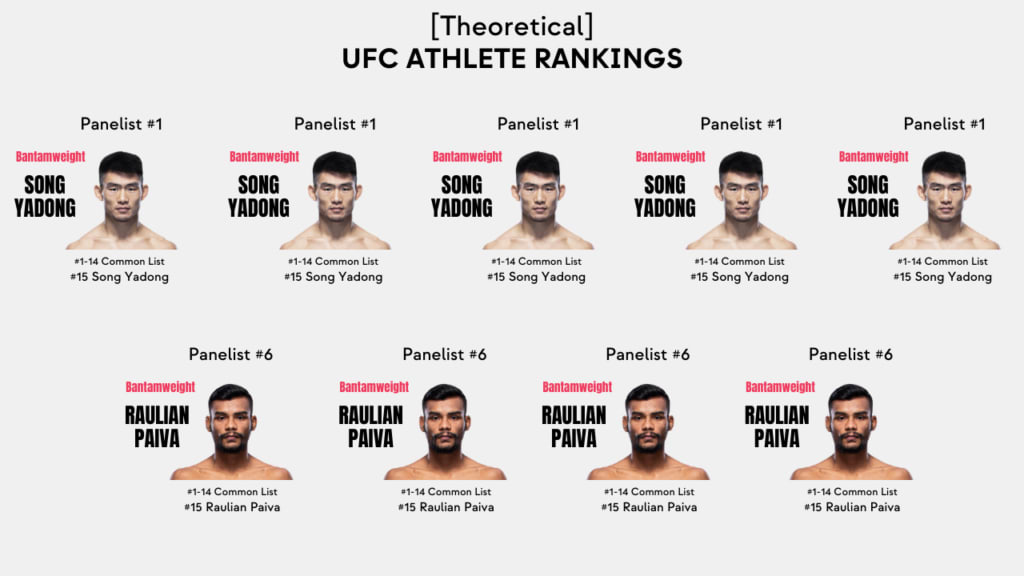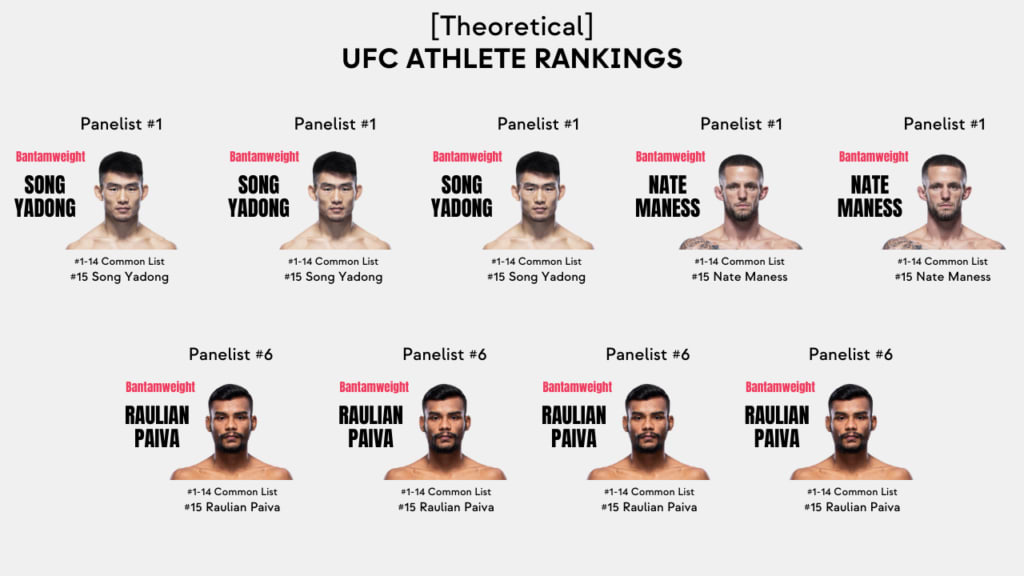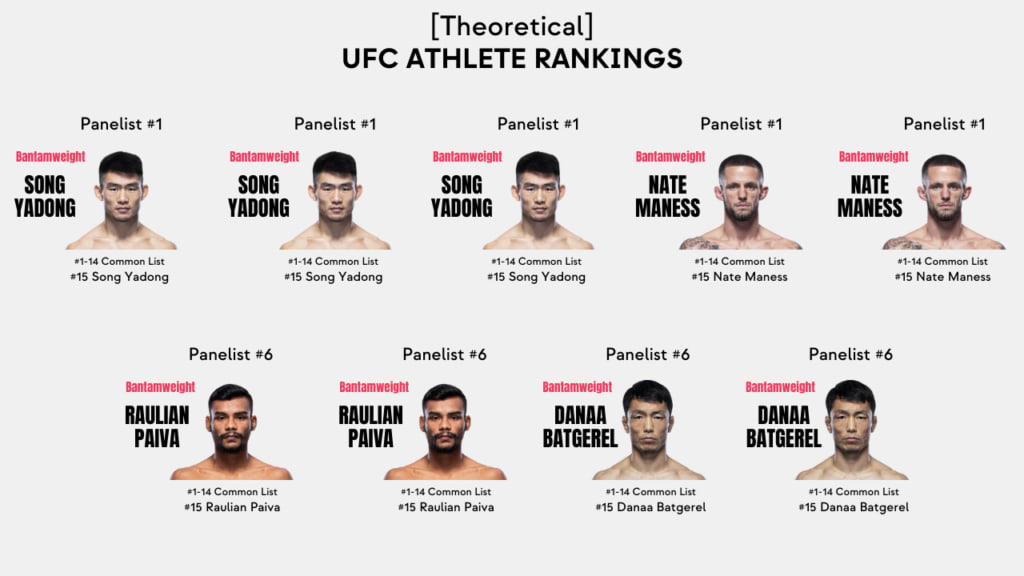Daniel Vreeland is on the UFC rankings panel . This deep dive is based on his experience with the system as a voting member.
For a lot of fans, and even for some fighters, the UFC’s ranking system can seem confusing. The transparency by the UFC has varied surrounding the system since its inception and the information that is available is often in many different places. Here’s what I know.
The History
The UFC’s ranking system was first implemented in February of 2013. To give a little perspective to this timeline, this was the same month that the first-ever women’s division was added, women’s bantamweight. While the ranking system is often a cause of consternation for fans across social media, it actually was born from a public outcry for its creation.
The wheels were already turning for a ranking system voted on by media members, but that talk seemed to accelerate when Nick Diaz was booked for a title shot against Georges St. Pierre. Diaz was coming off of an interim title loss to Carlos Condit and had not won in a year and a half. He was far from the first, or the last, to be granted a title shot off of a loss.
Although there is no way to directly link the two together, in between the announcement of his title fight and the fight itself, the rankings were rolled out – seemingly appeasing those who challenged the UFC to have reasoning behind their title challengers.
The Ranking Panel
The UFC ranking panel was constructed initially by the UFC reaching out to interested parties. Dana White had originally promised that there would be a robust panel of eighty members. However, when those first rankings dropped in February of 2013, the panel contained just twenty-eight names.
The panel contained names from print, online, and audio media to start. While the names that were originally there have come and gone, the rough number of panelists has largely stayed the same. Today, the UFC has twenty-two members of the voting panel, who log their rankings after each event. The make-up of that panel, in terms of the type of media represented, is still largely the same.
While much of the structure has stayed the same for the panel, there have been some larger changes to how their picks are, or aren’t displayed. When the rankings first hit the web, the UFC offered a drop-down menu at the top that allowed people to see each panelist’s individual rankings. However, that changed in January of 2020. The panel had dwindled a little in terms of how many people were on it.
In response, the UFC added a number of new names to that list. In doing so, they made two major changes. The first was that the individual names of the panelists were no longer available. Instead, the UFC gives a list of media outlets represented (you can see this at the bottom of the rankings page under ‘How are the Rankings Determined’). At this time, they also took away the drop-down menu and fans’ ability to see individual panelists’ votes. A reason for this change was never given.
The Process
After each and every week after an event, the ranking panel is asked to send in their ranking changes to their previous rankings. They do this through a drag and drop system that is operated by a third party outside of the UFC. The system saves the individual panelist’s previous rankings so that they can simply move people based on where they previously had them rather than where the collective voting panel had them.
When ranking, panelists are asked to vote for who they feel are the top fighters in each weight class and pound-for-pound, but that instruction is left to some level of interpretation. There is no guidance given based on how much to consider inactivity or head-to-head results for instance. Instead, they allow each panelist to weigh factors such as that in their own way.
After the voting window closes on Monday, the UFC typically releases their updated rankings on Tuesday. Those rankings show only changes in movement from one spot to another, but do not show changes in the aggregate score of an individual’s rankings.
So even if one fighter was garnering more or higher votes, but didn’t change ranking, there would be no reflection of that in the results. In addition, the way that the UFC, or rather the third-party system, calculates out the individual scores is not made public to fans or the panelists themselves.
Because the third party system has a drag-and-drop functionality, the fighters that can be voted for are preset. The system adds fighters when they have fought in the UFC or sometimes when they are signed. Fighters are also occasionally removed due to inactivity or no longer being under contract. This causes a gap in the rankings that panelists have to fill for themselves.
Recently, fans have begun tracking the availability of fighters to the rankings through the “Fan Rankings” feature on the UFC’s website. The availability of fighters appears to be similar on both fronts as savvy media members have been quick to report fighters missing from the “Fan Rankings” even before the official ones have been released.
Fan Confusion
One of the biggest issues that people have with the rankings is movement that does not appear to make sense. Many times there are fighters who move up or down, or even out of the rankings, without having fought. To make it even more confusing, the fighter switching places with them also may not have fought. While this does cause frustration, let me try to explain with a theoretical scenario.
Example
In late 2021, the bantamweight division saw its #15 fighter change in back-to-back weeks. First it was Song Yadong, followed by Raulian Paiva, followed by Song Yadong again. With neither of these two fighting, fans speculated that the change was to make upcoming fights look more interesting. This brought even more attention being that Paiva had been booked with Sean O’Malley – a fan favorite. Let’s look at a theoretical scenario to illustrate how the behind-the-scenes voting would have impacted on that ranking.

Let’s say that we had a theoretical nine-member panel. In the image above, you can see each member’s votes for the #15 spot at bantamweight. This is obviously smaller than the actual panel, and a larger panel would actually allow more variance. This example also assumes that all members agree on slots #1-14.
In actuality, the fact that Yadong could possibly be ranked even higher would create more chaos as well. Instead, we tried to keep this instance as simple as possible. In this example, you can see that Song Yadong has five votes to Raulian Paiva’s four. This would give Song Yadong the #15 spot.

The second week in question saw Nate Maness knock out Tony Gravely and move to 3-0. If we assume that this win impressed a couple of the panel members, you might see a few switch their #15 picks to Maness. If those affected Song more heavily than Paiva, we could see Paiva move ahead. Here, Paiva would have the most votes with the same four that he previously had.

The third week in question saw Yadong return to the #15 spot. The previous weekend had Danaa Batgerel knocking out Brandon Davis for his third straight KO victory. Again, if we assume this swayed some voters, but not all, and it affected Paiva disproportiately to other fighters, we could see him lose his spot back to Yadong. Here, Yadong still has three votes, as he did last week. However, those three votes would not be the most of anyone in that #15 spot. Again, this switch back and forth would happen twice in as many weeks with neither fighting.
The lack of transparency in these cases, combined with fans’ tendencies to assume something nefarious, leads to discontent with the system. However, as with any aggregate point system, occasionally the math and what you cannot see makes a lot of things happen. This would, of course, be much easier if the UFC showed rankings or the formula for the totals, but neither of those are currently available.
If you have additional questions for Dan Vreeland about how the rankings work, you can drop a comment below or ask him via Twitter (@GumbyVreeland).

